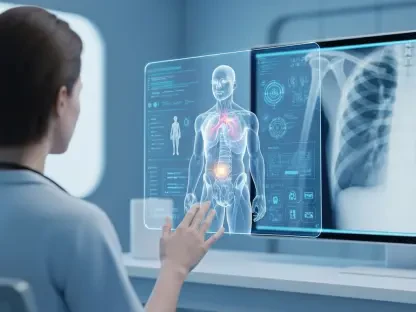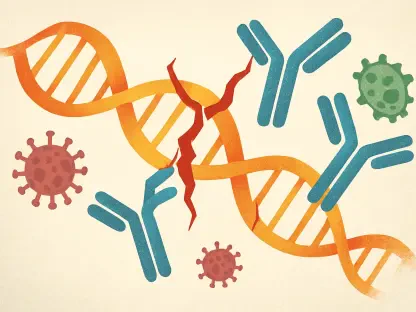In the ever-evolving landscape of medical diagnostics, a profound shift is underway, driven by the remarkable capabilities of artificial intelligence (AI). Brain tumor diagnosis, a critical area where precision and speed can mean the difference between life and death, has long been hampered by the limitations of traditional methods that rely on human interpretation of complex imaging such as MRI and CT scans. Errors in diagnosis or delays in results can drastically alter patient outcomes, creating an urgent need for innovation. AI emerges as a beacon of hope, offering the potential to enhance accuracy, reduce human error, and accelerate the diagnostic process in ways that were once thought impossible. By harnessing advanced technologies like deep learning ensemble frameworks, the medical field stands on the brink of a revolution that could transform how brain tumors are detected and treated. This development not only promises to support clinicians but also to improve the quality of care for countless patients around the globe.
Unlocking New Possibilities with AI in Diagnostics
The integration of AI into medical diagnostics marks a significant leap forward, particularly in the challenging realm of brain tumor identification. Traditional diagnostic approaches often rely on the subjective analysis of radiologists who painstakingly examine imaging data, a process that can be both time-consuming and prone to mistakes due to factors like fatigue or varying levels of expertise. AI, through sophisticated systems like deep learning ensemble frameworks, automates this analysis with an unprecedented level of precision. By processing vast amounts of data at remarkable speeds, these systems have demonstrated the ability to surpass earlier benchmarks in accuracy, providing reliable results that can guide critical medical decisions. This automation not only saves valuable time but also offers a layer of consistency that human interpretation sometimes lacks, positioning AI as a transformative force in healthcare settings.
Beyond mere automation, AI serves as a vital partner to medical professionals, enhancing rather than replacing human expertise. Deep learning models analyze intricate details within MRI and CT scans, delivering insights that might be overlooked by the human eye. This complementary role allows radiologists to shift their focus from exhaustive image analysis to strategic treatment planning and patient interaction. The synergy between AI technology and clinical skill creates a dynamic where diagnostic accuracy is bolstered, ultimately benefiting patient care. As AI continues to evolve, its potential to refine workflows in hospitals and clinics becomes increasingly evident, suggesting a future where technology and medicine work hand in hand to tackle some of the most pressing health challenges with greater efficiency and reliability.
The Strength of Diversity in Data and Algorithms
A key strength of AI-driven brain tumor diagnosis lies in the use of diverse training data to build robust diagnostic models. Deep learning ensemble frameworks are trained on extensive datasets that include brain tumor images of varying types, sizes, and characteristics, ensuring a comprehensive understanding of the condition’s many presentations. This broad exposure allows the AI to recognize subtle patterns and anomalies across a wide spectrum of cases, significantly reducing the risk of overfitting—a common pitfall where models excel on familiar data but falter in real-world applications. By grounding the system in such a varied foundation, developers create a tool that is not only accurate but also adaptable to the unpredictable nature of clinical environments, offering a level of reliability that is crucial for effective diagnosis.
Equally important is the innovative combination of algorithmic approaches within these ensemble frameworks. By integrating tools like convolutional neural networks (CNNs), which excel at extracting detailed features from medical images, with decision trees that provide logical classification capabilities, the system leverages the unique strengths of each component. This hybrid methodology results in a diagnostic tool that is both precise in its analysis and systematic in its decision-making process. Such a design mitigates the weaknesses of individual models, creating a cohesive solution that can handle the complexities of brain tumor classification with remarkable finesse. The outcome is a technology that not only meets the demands of modern diagnostics but also sets a new standard for what AI can achieve in the medical field.
Expanding Horizons in Healthcare Applications
The implications of AI in brain tumor diagnosis extend far beyond a single application, hinting at a broader transformation across healthcare. The data-driven design of deep learning ensemble frameworks suggests scalability to other medical imaging tasks, such as detecting abnormalities in cardiology or pulmonology scans. This adaptability positions AI as a versatile tool capable of addressing a range of diagnostic challenges with a unified approach. As research progresses, the potential to tailor these models to various medical fields could streamline workflows in diverse specialties, reducing diagnostic bottlenecks and enhancing overall efficiency in patient care. Such scalability underscores the transformative power of AI, pointing to a future where a single technological framework could underpin multiple aspects of healthcare delivery.
Collaboration across disciplines further amplifies the impact of this technology. Bringing together computer scientists, radiologists, and oncologists ensures that AI tools are not only technically advanced but also practically relevant to clinical needs. This interdisciplinary approach facilitates the refinement of algorithms to align with real-world medical scenarios, bridging the gap between innovation and application. By fostering dialogue between technology developers and healthcare providers, the integration of AI into clinical settings becomes smoother, addressing potential challenges like user adoption and system compatibility. This collaborative spirit is essential for maximizing the benefits of AI, ensuring that advancements translate into tangible improvements for both medical professionals and the patients they serve.
Empowering Personalized Care Through Precision
One of the most compelling benefits of AI in brain tumor diagnosis is its capacity to advance personalized medicine. Accurate classification of tumors based on their unique biological traits enables clinicians to design treatment plans that are specifically tailored to each patient’s condition. This level of precision is critical, as tumors can vary widely in their behavior and response to therapy. By providing detailed diagnostic insights, AI empowers doctors to select the most effective interventions, potentially improving outcomes and minimizing unnecessary side effects. This shift toward individualized care represents a significant step forward, creating a healthcare landscape where treatments are as unique as the patients themselves, enhancing the overall effectiveness of medical interventions.
Moreover, the speed and accuracy of AI-driven diagnostics facilitate faster decision-making, which is often crucial in brain tumor cases where timing can impact prognosis. Rapid identification of tumor characteristics allows for prompt initiation of treatment, reducing the window during which a condition might worsen. This efficiency not only benefits patient health but also alleviates some of the pressure on healthcare systems by optimizing resource allocation. As AI tools become more integrated into routine practice, they pave the way for a model of care that prioritizes both precision and timeliness, ensuring that patients receive the most appropriate and immediate attention possible. This focus on tailored, swift responses highlights the profound potential of AI to reshape the future of medical treatment.
Reflecting on Milestones and Future Pathways
Looking back, the strides made in applying AI to brain tumor diagnosis through deep learning ensemble frameworks marked a pivotal moment in medical technology. These systems demonstrated exceptional accuracy, surpassing previous standards and providing clinicians with reliable tools to enhance patient outcomes. The emphasis on diverse data, algorithmic synergy, and interdisciplinary collaboration laid a strong foundation for integrating such innovations into everyday healthcare practices. This achievement reflected a broader trend of technology converging with medicine to address complex challenges, setting a precedent for how diagnostics could evolve.
Moving forward, the focus should shift to expanding the reach of these AI tools, adapting them to additional medical domains, and ensuring their accessibility in varied clinical settings. Continued research and validation are essential to refine their capabilities and confirm their efficacy across diverse patient populations. Strengthening partnerships between technologists and healthcare providers will be key to overcoming implementation hurdles and maximizing impact. By pursuing these steps, the medical community can build on past successes, driving toward a future where AI enhances diagnostic precision and personalizes care on a global scale.









